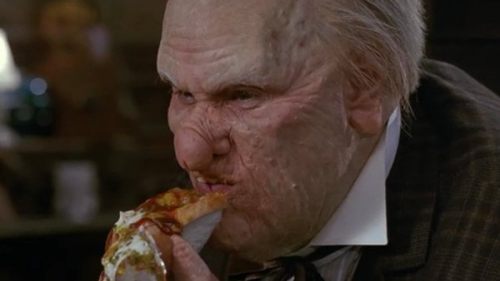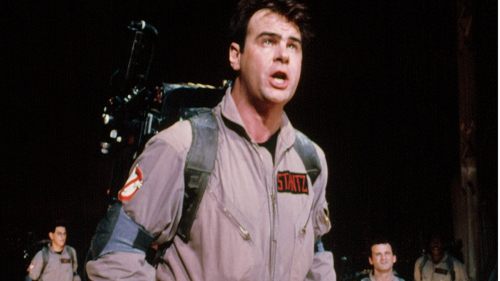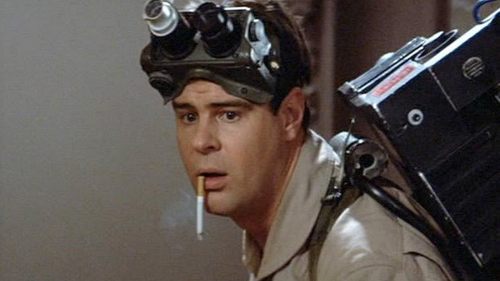This Movie Has Everything: John G. Avildsen’s NEIGHBORS (1981)
John Belushi’s last film role. Dan Aykroyd as a could-be Nazi. Catherine Moriarty ushering an entire generation into puberty. The worst film score ever. Edible panties, Tim Kazurinsky and radio-controlled airplanes. This movie has everything.
To properly appreciate John G. Avildsen’s Neighbors (1981, based on a book of the same name by Thomas Berger), one must arrive informed. If one doesn’t know the history of the production - everything from the last minute switcheroo of roles for stars Dan Aykroyd and John Belushi to Avildsen’s Oscar win for Best Director five years prior to Belushi’s disastrous cocaine habit - one might be tricked into thinking that the entire project is a colossal failure, a sour end to Belushi's far-too-brief career on film. But Neighbors isn’t just a failure: it’s one of the most fascinating failures you’ll ever see, much like - to use a related example - the notoriously bizarre Dan Aykroyd Unplugged on UFOs (add to your Netflix Instant queue immediately, thank me later).
Ostensibly, the film’s a pitch-black comedy about the living hell that is life in the suburbs (a subject that was very much on Middle-Class America’s mind back when the film was made), but just beneath the surface roils a staggeringly odd stew made up of such disparate ideas as emasculation, Nazism, swingers and the inherent strangeness of Middle America. Having never read the original novel on which the film was based, I can’t say with any certainty whether or not these undercurrents were transplanted from that source material…but based on the limited amount of online info available about both the film and novel, it seems unlikely. Instead, it’s probable that this mishmash of themes is symptomatic of the ongoing rewrites the script (written by M*A*S*H's Larry Gelbart) underwent during production. Aykroyd and Belushi were behind those changes, and it’s just one of many ways the pair attempted to undermine (or improve, depending on your point of view) Avildsen’s film during production.
But let’s not get ahead of ourselves. Here’s the setup: Earl (Belushi) and Enid Keese (Kathryn Walker) live at the end of Bird Lane, a cul-de-sac on which sits their house...and the house next door. Other than these homes, the street is barren, overgrown scrubland abutted by a swamp (?!) and overseen by an ominously buzzing set of power-lines. It’s clear the Keese family isn't particularly fond of the stale existence they've found here, but things pick up when two new neighbors - Vic (Aykroyd) and Ramona (a smoldering Catherine Moriarty) - arrive. Soon enough, they’re at his door. Sooner still, Vic and Ramona are turning Earl’s life upside down in a variety of weird, intimidating ways. The harder Earl struggles to bring these behaviors to the attention of his wife and daughter, the more it blows up in his face. Things escalate quickly, and by the end at least one family's home is burned to the ground, an El Camino has been eaten (and regurgitated) by the swamp, and Earl has found a solution to the dreariness that’s been plaguing his life.
All of this sounds like it could unfold in a fairly straightforward manner. It is, in fact, the setup for a classic screwball comedy: you’ve got two giant houses, people coming and going at random moments, odd characters showing up out of nowhere to poke and prod the proceedings along. I can easily imagine a stage-based version of this story, one that plays like a bastard child of Noises Off and Freddie Got Fingered. And when you add to that setup the involvement of Belushi and Aykroyd, at the time two of the biggest comedy stars in the world, as well as the Oscar-winning director of Rocky, it’s easy to see why Columbia would’ve gladly shelled out the $8m budget the film required. On paper, this was a slam-dunk.
But the problems started before a single frame was shot. Midway through pre-production, Belushi and Aykroyd announced that they were going to flip-flop their roles, with the former playing the straightman and the latter as the increasingly dangerous, perpetually wacky Vic. On the one hand, this must have immediately alarmed everyone invested in the making of the film, for obvious reasons. On the other hand, it’s easy to see why this idea might’ve ultimately been accepted: playing against type sometimes yields incredibly satisfying results. Besides, Avildsen was coming off a string of disappointments in the wake of Rocky (he’d been dumped from his director’s position on Saturday Night Fever, and neither film he’d made since his Oscar win - Slow Dancing in The Big City (1978) and The Formula (1980) - had been a commercial or critical success), and who was he to tell the stars of The Blues Brothers and Animal House their business, comedy-wise?
Unfortunately (?), it was just the first of many dust-ups that would occur on the set. Aykroyd and Belushi (especially the latter) butted heads with their director throughout the production, rewriting the script Avildsen had signed on to helm on a nearly daily basis and attempting to impose other, less substantial changes to the film’s genetic makeup (Belushi, for instance, wanted the punk band Fear to record a song for the film’s end credits; when his lobbying failed on that front, the band made a notoriously troubled appearance as musical guests on SNL). All of this was surely exacerbated by the fact that cocaine enthusiast John Belushi was at the height of his addiction, and indeed that addiction apparently threatened to derail the entire production throughout filming. Knowing that, the fact that Belushi appears so mannered, so un-manic in his role as Earl Keese only serves to make everything seem even stranger.
And those undercurrents! The most baffling is easily the aforementioned Nazi stuff. What to make of the fact that Aykroyd’s Vic spends one sequence cradling a large book emblazoned with a swastika? Or the fact that he has a German-speaking German Shepherd, his hair dyed Aryan blonde, and a radio-controlled scale model of the Red Baron’s tri-plane (yes, yes: the Red Baron was actually a player in WWI, but surely the Germanic connection isn’t coincidence)? Or the fact that Keese is actually a name of Hebrew descent? What, precisely, is being said between the lines here? And how the hell does it relate to the very obvious primary theme of “Suburbs as Hell”?
Far more troubling than the Nazi allusions? The film’s score, a soul-crushing aural assault that inexplicably includes the sort of "zany" flourishes and embellishment one might normally associate with an early '50s sci-fi flick. For this, we have Bill Conti to thank. This is the same guy who scored Rocky and The Thomas Crown Affair, so let's try not to be too smug about it. One can kind of see what he was going for here - perhaps it was an effort to even out some of the film’s darker touches, to soften some of the film's more acidic exchanges - but it fails, miserably and completely. Within moments of the film's opening the score's annoying us, which means that by the end you sort of understand how Belushi thought sending audiences out of the theater to the screeching strains of Fear was preferable.
Don’t let me lead you to believe, however, that all of Neighbors’ weirdness is bad. There’s a lot of pleasant weirdness taking place, from fun little grace notes (Vic’s consistently hilarious wardrobe, up to and including the frog-man diving suit/shotgun ensemble he appears in late in the film) to a very welcome guest appearance (Tim Kazurinsky! Holy shit, I forgot all about Tim Kazurisnky!) to Catherine Moriarty operating at full Catherine Moriarty. And for as questionable as the casting switch may seem now that we know the film doesn't quite work, it is admittedly kind of awesome to see Belushi as the straightman for once (let’s not pretend any of us have actually ever seen Continental Divide, even though we keep saying we will). These are the fun parts of the film, constantly working at odds with the decidedly not fun score, editing and stylistic tics Avildsen felt inclined to put into service. Every scene is its own little comedy/tragedy. It’s fascinating.
I hadn’t seen the film in years before watching it again for this piece, and, quite honestly, it had been long enough for me to have forgotten large chunks of the narrative, not to mention all the subtleties and undercurrents that...well, those were lost on me the first few times around, let's be frank. I first caught the film as a kid, back when the film seemed to be a late-night programming favorite for HBO. Heretofore, if you'd asked my opinion I would've told you that Neighbors was a “good” movie and worth seeking out. Having revisited the film, I feel I have to revise my verdict: it probably doesn’t qualify as “good” (not in the common definition of the word, anyway), and it probably isn’t worth seeking out for casual Belushi/Aykroyd fans. But for advanced film geeks, for those with a penchant for dark humor or fans of long-forgotten cinematic oddities, Avildsen's film really does have everything.
NOTE: If you wish to seek the film out on your own, you’ll have to buy it via Amazon’s DVD-R “On Demand” service at the link below (unless you’re partial to VHS). It’s not on Netflix, and there sure as hell aren’t any Blu-ray quality versions floating around. Is it worth the $20 or so you’ll have to pay to see it? If you’re a fan of Belushi, Aykroyd or anyone else involved with the production, the answer is “almost certainly,” just as long as you realize that you’re picking up something that’s more of an oddity than it is a comedy classic.



